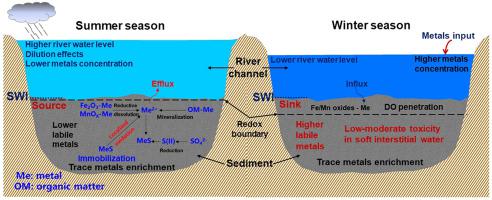Journal of Hazardous Materials ( IF 12.2 ) Pub Date : 2020-11-17 , DOI: 10.1016/j.jhazmat.2020.124590 Lei Gao , Rui Li , Zuobing Liang , Qirui Wu , Zhigang Yang , Manzi Li , Jianyao Chen , Lei Hou

|
Identifying the mobilization mechanisms and predicting the potential toxicity risk of metals in sediment are essential to contamination remediation in river basins. In this study, a sequential extraction procedure and diffusive gradients in thin film (DGT) were employed to investigate the mobilization mechanisms, release characteristics, and potential toxicity of sediment metals (Cu, Zn, Ni, and Pb). Acid-soluble and reducible fractions were the dominant geochemical species of Cu, Zn, Ni, and Pb in sediments, indicating high mobility potentials for these metals under reducing conditions. In summer, the sediment acted as a source of water-column metals due to mineralization of organic matter and reductive dissolution of iron/manganese oxides in surface sediments, and the formation of metal sulfide precipitates markedly lowered DGT-labile metal concentrations with depth, while localized sulfide oxidation was responsible for fluctuating labile metal concentrations. Stable distribution patterns of labile metals resulted from the weak reducing conditions of sediment in winter, when the sediment shifted to a metal sink. The interstitial water criteria toxicity unit (IWCTU), calculated from DGT measurements, indicated no and low-to-moderate toxic risk of sediments in summer and winter seasons, respectively, and Pb was the major contributor to the predicted toxic effects in the soft interstitial water.
中文翻译:

基于薄膜扩散梯度的沉积物痕量金属(铜,锌,镍和铅)的动员机理和毒性风险-以华南西直河流域为例
识别动员机制并预测沉积物中金属的潜在毒性风险对于河流流域的污染修复至关重要。在这项研究中,采用连续萃取程序和薄膜(DGT)中的扩散梯度来研究沉积物金属(铜,锌,镍和铅)的迁移机理,释放特性和潜在毒性。酸溶和可还原馏分是沉积物中Cu,Zn,Ni和Pb的主要地球化学物种,表明这些金属在还原条件下具有很高的迁移潜力。在夏季,由于有机物的矿化作用和铁/锰氧化物在表层沉积物中的还原性溶解,沉积物成为水柱金属的来源,金属硫化物沉淀物的形成随着深度的增加显着降低了DGT不稳定金属的浓度,而局部硫化物的氧化是不稳定金属浓度波动的原因。不稳定的金属的稳定分布模式是由于冬天沉积物迁移到金属水槽时沉积物的还原条件较弱所致。由DGT测量得出的间隙水标准毒性单位(IWCTU)分别表明夏季和冬季沉积物的毒性风险没有和中度到中度,铅是软质间隙中预测毒性作用的主要贡献者水。不稳定的金属的稳定分布模式是由于冬天沉积物迁移到金属水槽时沉积物的还原条件较弱所致。由DGT测量得出的间隙水标准毒性单位(IWCTU)分别表明夏季和冬季沉积物的毒性风险没有和中度到中度,铅是软质间隙中预测毒性作用的主要贡献者水。不稳定的金属的稳定分布模式是由于冬天沉积物迁移到金属水槽时沉积物的还原条件较弱所致。由DGT测量得出的间隙水标准毒性单位(IWCTU)分别表明夏季和冬季沉积物的毒性风险没有和中度到中度,铅是软质间隙中预测毒性作用的主要贡献者水。











































 京公网安备 11010802027423号
京公网安备 11010802027423号